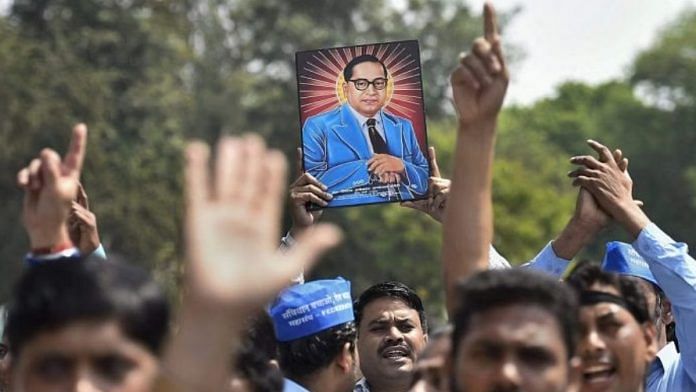The anti-caste movement has a long and rich social history. It has encompassed resistance since the times of Buddhism, Bhakti traditions, and later in different colonial and post-colonial moments. The spectrum of anti-casteism is thus diverse, consisting of multiple icons, histories, and expanding across geographies.
However, in the current political scenario, the engagement with anti-casteism is selective. It is marketed and narrativised in a way that’s just a façade of engaging with what anti-casteism is in its true essence. The leading political parties’ pretensions of being anti-caste are devoid of a real understanding of the diverse anti-caste paradigms that were socio-culturally constructed and evolved over a period.
Being ‘anti-caste’ has thus become a buzzword that creates immediate political attention. But what is the social history that forms the bedrock of this term? It seems no one cares about that.
Also Read: Ambedkar in a savarna mundu? Why Babasaheb’s clothes matter
What are anti-caste movements?
Anti-caste movements pre-date colonialism, with roots in Buddhism and later in radical Bhakti traditions. When one reads Ravidas (1450-1520), one can find the earliest imagination of a casteless society, in his idea of Begumpura. In his vani (Sri Guru Granth Sahib, Part 1, Raag Gauri), Ravidas imagines a world that is devoid of hierarchy and where equality prevails irrespective of social status. Kabir’s writings in Bijak and his poetry in the Ulatbansi (upside-down language) style also represent a thoughtful approach to reversing a social order that was otherwise determined by superstition and caste biases. Similarly, Tukaram’s abhangas, Namdeo’s bhajans, Sant Gadge Maharaj’s kirtans, among others, used songs and poetry to question caste structures and advocate for a new social order.
Within Bhakti traditions, cultural churning was an important tool to foreground anti-caste sentiments. The poetic techniques and myriad imaginative persuasion methods were used to make people aware and convince them to embrace a casteless society. However, a direct influence of this cultural churning was seldom visible in the political sphere.
During the early 20th century, the anti-caste movement in North India gained momentum through the rise of the Adi-Hindu movement. The Arya Samaj was also known for its anti-caste stance, although scholars have argued that it incorporated casteist practices like ‘shuddhi’ (purification of untouchables).
In contrast, the lesser-acknowledged works of Swami Achuthananda, Babu Mangu Ram Mugowalia, BA Santram, and others outrightly questioned the caste-based social order. Babu Mangu Ram was a founding member of the Adi-Dharma movement in Punjab. Similarly, Swami Achuthananda’s Adi-Hindu movement was at the centre of asserting Dalit-Bahujan identity. It questioned Aryan theory and argued that Dalits were the original inhabitants of India—the Adi-Hindu, or Moolnivasi as it is popularly referred to in contemporary times.
The works of Bahujan leader BA Santram, such as Humara Samaj, Mere Jiwan ke Anubhav, and others, exposed the social problems caused by the caste system. Like the Bhakti saints, Santram, in his book Humara Samaj, emphasises the need for social independence, advocating for the possibility of intermingling and intermarriage between communities, irrespective of their social statuses.
Many anti-caste thinkers, including Jyotiba Phule, Savitribai Phule, EVR Periyar, Iyothee Thass, Kashi Baba, Kanshi Ram, Narayana Guru, and Periyar Lalai Singh Yadav, created discrete public spheres that had received mass support. However, one person who unified them all was Dr BR Ambedkar. Not only did Ambedkar read each of them closely, as is reflected in his writings, he also established close conversations with his contemporaries. Social historian Nandini Gooptu has also highlighted the support that the Adi-Hindu movement extended to Ambedkar, by mobilising ‘untouchables’ in his favour, during the 1932 Poona Pact with MK Gandhi for reserving seats for ‘depressed classes’ in legislative councils.
Ambedkar’s contribution to the anti-caste movement remains momentous, not just because of his socio-political contributions but the dedication of his entire being to the Dalit-Bahujan cause. His immensely powerful anti-caste literature today appeals across ideological standpoints. He engaged with the question of caste in terms of its genesis, mechanisms, and everyday practice. It’s not an exaggeration to say that it was Ambedkar’s commitment that unified diverse anti-caste spheres under a common rubric.
Also Read: Not Manusmriti, British—caste system in medieval Tamil Nadu solidified after Cholas fell
The problem
Despite the diversity of anti-caste movements, icons, and histories, there is an unfortunate looseness with which the anti-caste question is taken up, specifically within the political sphere. This superficial approach toward anti-caste history attempts to whitewash everything into a single narrative. This is the biggest irony as each of the anti-caste moments employed unique ways of breaking the structures of caste.
When a political party attempts to honour Ravidas, Buddha, Tukaram, Baba Gadge, or Kabir, the emphasis is on making visits to significant sites or, at most, beautifying such spaces. But there is a gross neglect of the knowledge production and cultural effervescence underlying the legacies of each of these myriad icons.
This appropriation further erases the history and cultural complexities of anti-caste movements, and instead manipulates them to suit a vested political agenda. Meaningful engagement and contribution are lacking. For instance, consider how much research funding is actually given to explore the work of diverse anti-caste icons. It’s almost negligible! If at all select research grants are given, these are directed toward more prominent figures like Ambedkar, whose visibility fetches brownie points and promises immediate political gratification.
Consequently, the many histories that built up the anti-caste movement—even those that informed and influenced Ambedkar—are completely forgotten and erased. ‘Anti-caste’ instead has been reduced to a hollow catchphrase that is selectively and temporarily used as and when suited.
This article is part of the Dalit History Month series.
K. Kalyani is Assistant Professor at Azim Premji University, Bengaluru. She tweets at @FiercelyBahujan.Views are personal.
(Edited by Asavari Singh)



